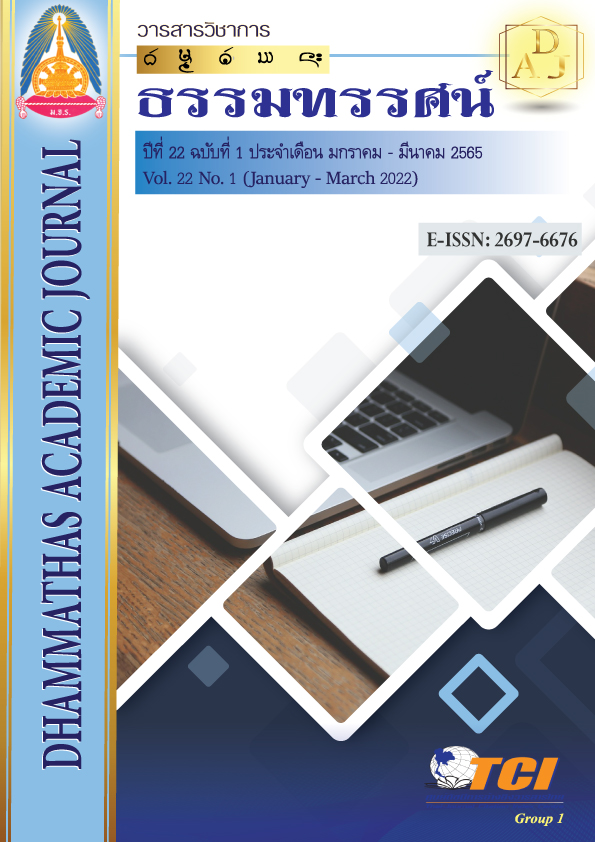Teachers’ Questioning to Elicit Students’ Mathematical Ideas in Problem Solving Classroom
Main Article Content
Abstract
This study aimed to analyze the teachers’ questioning to elicit students’ mathematical ideas in problem solving classroom. It's qualitative research. The target group consisted of a lesson study team comprising five people and a total of eleven fifth-grade students studying in semester 1/2021 at Ban Bueng Niam Bueng Khianun Tha Hin school, Khon Kaen. The data collection was using lesson plans, filed note and Messenger application. The collected data was analyzed by NCTM and Isoda & Katagiri framework.
The study found that: teachers’ questioning to elicit students’ mathematical ideas as follows 1) Gathering information questions led students to review their background knowledge, prompting them to gather information pertaining to ideas of decimal units to form the basis of the solution to the problems they faced, and in some instances they drew on ideas of sets which is about multiplying decimals to solve problems concerning groups. 2) Probing thinking questions elicited the students’ ideas of decimal units, representation of decimal multiplications, operation of decimal multiplications and algorithm of decimal multiplications in solving the problems they faced. 3) Encouraging reflection and justification questions stimulated the students to explain their ideas of decimal units, representation of decimal multiplications, operation of decimal multiplications and algorithm of decimal multiplications arising from the problem solving on their own, understand and argue ideas correctness. 4) making the mathematics visible questions prompted students to discuss ideas of algorithms. These findings can be used to develop learning tools for future lessons.
Article Details

This work is licensed under a Creative Commons Attribution-NonCommercial-NoDerivatives 4.0 International License.
เพื่อให้เป็นไปตามกฎหมายลิขสิทธิ์ ผู้นิพนธ์ทุกท่านต้องลงลายมือชื่อในแบบฟอร์มใบมอบลิขสิทธิ์บทความ ให้แก่วารสารฯ พร้อมกับบทความต้นฉบับที่ได้แก้ไขครั้งสุดท้าย นอกจากนี้ ผู้นิพนธ์ทุกท่านต้องยืนยันว่าบทความ ต้นฉบับที่ส่งมาตีพิมพ์นั้น ได้ส่งมาตีพิมพ์เฉพาะในวารสาร วิชาการธรรม ทรรศน์ เพียงแห่งเดียวเท่านั้น หากมีการใช้ ภาพหรือตารางของผู้นิพนธ์อื่นที่ปรากฏในสิ่งตีพิมพ์อื่นมาแล้ว ผู้นิพนธ์ต้องขออนุญาตเจ้าของลิขสิทธิ์ก่อน พร้อมทั้ง แสดงหนังสือที่ได้รับการยินยอมต่อบรรณาธิการ ก่อนที่บทความจะได้รับการตีพิมพ์References
ไมตรี อินทร์ประสิทธิ์. (2546). การปฏิรูปกระบวนการเรียนรู้วิชาคณิตศาสตร์ในโรงเรียน โดยเน้นกระบวน การทางคณิตศาสตร์. ขอนแก่น: ขอนแก่นการพิมพ์.
_______. (2557). กระบวนการแก้ปัญหาในคณิตศาสตร์ระดับโรงเรียน. ขอนแก่น: เพ็ญพรินติ้ง.
_______. (2564). Blended Learning Classroom [เทปบันทึกเสียง]. ขอนแก่น: มหาวิทยาลัยขอนแก่น.
สัมพันธ์ ถิ่นเวียงทอง และไมตรี อินทร์ประสิทธิ์. (2561). รูปแบบการสอนแนวใหม่สำหรับการวัดในรายวิชาคณิตศาสตร์ระดับโรงเรียน. วารสารมหาวิทยาลัยนครพนม, 8(3), 118-127.
สำนักงานเลขาธิการสภาการศึกษา. (2561). แผนการศึกษาแห่งชาติ พ.ศ. 2560-2579. กรุงเทพฯ: พริกหวานกราฟฟิค.
Eddy, C. M. & Harrell, P. E. (2013). Assess today: A short-cycle formative assessment observation protocol. Texas: University of North Texas.
Inprasitha, M. (2011). One Feature of Adaptive Lesson Study in Thailand: Designing a Learning Unit. Journal of Science and Mathematics Education in Southeast Asia, 34(1), 47-66.
Isoda, M. & Katagiri, S. (2012). Mathematical Thinking: How to Develop it in the Classroom. Singapore: World Scientific Publishing Co. Pte. Ltd.
Isoda, M., & Nakamura, T. (2010). Mathematics Education Theories for Lesson Study: Problem Solving Approach and the Curriculum through Extension and Integration. Journal of Japan Society of Mathematical Education, 92(5),
Lewis, C. (2002). Lesson Study: A handbook of teacher-led Instructional change. Philadelphia: Research for better schools, Inc.
Mehan, H. (1979). Learning lessons: Social organization in the classroom. Cambridge, MA: Harvard University Press.
Meserve, B., & M. Suydam. (1992). In Studies in Mathematics Education: Moving into the Twenty-first Century. Paris: United Nations Educational.
National Council of Teachers of Mathematics. (2014). Principles to Actions: Ensuring Mathematical Success for All. Reston, Virginia: National Council of Teachers of Mathematics.
Shahrill, M. (2013). Review of Effective Teacher Questioning in Mathematics Classrooms. International Journal of Humanities and Social Science, 17(3), 224-231.
Shimizu, Y. (1999). Aspects of mathematics teacher education in Japan focusing on teacher’ roles. Journal of Mathematics Teacher Education, 2(1), 107-116.
Wood, T. (1998). Alternative Patterns of Communication in Mathematics Classroom: Funneling or Focusing?. In H. Steinbring, A. Sierpinska & M. G. Bartolini-Bussi (Eds.). Language and Communication in the Mathematics Classroom, (pp. 167-168). Reston, Virginia: National Council of Teachers of Mathematics.

